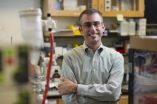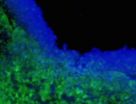(Press-News.org) Down syndrome is the most common chromosomal abnormality in humans, involving a third copy of all or part of chromosome 21. In addition to intellectual disability, individuals with Down syndrome have a high risk of congenital heart defects. However, not all people with Down syndrome have them – about half have structurally normal hearts.
Geneticists have been learning about the causes of congenital heart defects by studying people with Down syndrome. The high risk for congenital heart defects in this group provides a tool to identify changes in genes, both on and off chromosome 21, which are involved in abnormal heart development.
Researchers at Emory University School of Medicine, with colleagues at Johns Hopkins University, Oregon Health Science University, and University of Pittsburgh, report results from the largest genetic study of congenital heart defects in individuals with Down syndrome in the journal Genetics in Medicine.
The team found that infants with congenital heart defects, in the context of Down syndrome, were more likely to have rare, large genetic deletions. Those deletions tended to involve genes that affect cilia, cellular structures that are important for signaling and patterning in embryonic development.
These new findings, along with other recent studies, suggest that the risk for congenital heart defects in Down syndrome can come from several genes and environmental factors, in addition to the substantial risk from the extra chromosome 21.
"In Down syndrome, there's a 50-fold increase in risk for heart defects, which is enormous," says senior author Michael Zwick, PhD, associate professor of human genetics and pediatrics at Emory. "Studying congenital heart defects in the 'at risk' Down syndrome population can make it possible to reveal genes that impact the risk of heart defects in all children, including those with typical number of chromosomes."
"Understanding the origin of heart disorders in individuals with Down syndrome may reveal aspects of biology that would allow better personalization of their health care, since genetic alterations that affect the heart may also affect other organs, such as the lungs or gut," Zwick says.
"Our partnership with families who have a child with Down syndrome and our investment in a comprehensive clinical data and biorepository will continue to provide resources to study not only heart defects, but also other Down-syndrome associated medical conditions such as cognitive function, leukemia, and dementia," says co-author Stephanie Sherman, PhD, professor of human genetics at Emory University School of Medicine.
Sherman says the study was a collaborative effort involving participants with Down syndrome, their families and assessment sites across the United States, including those mentioned above along with Kennedy Krieger Institute, Children's National Medical Center and Ohio Nationwide Children's Hospital.
The first author was Emory postdoctoral fellow Dhanya Ramachandran, PhD, working with Zwick. Emory co-authors included assistant professors Lori Bean, PhD, Tracie Rosser, PhD and David Cutler, PhD, in the Department of Human Genetics, and Jennifer Mulle, PhD, assistant professor of epidemiology in the Rollins School of Public Health. Ken Dooley, MD, associate professor of pediatrics at Emory and pediatric cardiologist at Children's Healthcare of Atlanta, reviewed medical records and made definitive diagnoses for all study participants.
The study included 452 individuals with Down syndrome. 210 had complete atrioventricular septal defects (AVSDs), a serious heart defect that is relatively common among those with Down syndrome (about 20 percent). The remaining 242 had structurally normal hearts. The Emory team used high density microarrays to probe more than 900,000 sites across the human genome to detect structural variation, including deletions or duplications of DNA.
An atrioventricular septal defect means that the central region of the heart separating the atria from the ventricles has failed to form properly. Such defects increase the workload on the heart, and a complete AVSD leads to heart failure: fluid buildup in the lungs and difficulty breathing, requiring surgery in the first year of life.
The team's results add to evidence for a connection between AVSDs and cilia. Ciliopathies are a class of genetic disorders that include kidney, eye, and neurodevelopmental disorders. Cells in the airways have mobile cilia which sweep mucus and dirt out of the lungs, but almost every cell in the body has a primary (sensory) cilium.
"The finding that ciliome genes may be disrupted in children with Down syndrome and AVSD may indicate differences in life-time care for these individuals," Zwick says. "This is a suggestive result that needs replication in a larger group."
To confirm and strengthen the findings, Zwick and his team are currently performing an independent study of individuals with Down syndrome, using whole genome sequencing to further delineate alterations in genes that perturb heart development in children.
INFORMATION:
In early drug discovery, you need a starting point, says Northeastern University associate professor of chemistry and chemical biology Michael Pollastri.
In a new research paper published Thursday in the journal PLOS Neglected Tropical Diseases, Pollastri and his colleagues present hundreds of such starting points for potentially treating African sleeping sickness, a deadly disease that claims thousands of lives annually.
Pollastri, who runs Northeastern's Laboratory for Neglected Disease Drug Discovery, ...
WASHINGTON – October 24, 2014 – Policy options for climate change risk management are straightforward and have well understood strengths and weaknesses, according to a new study by the American Meteorological Society (AMS) Policy Program.
"Large gaps remain in society's consideration of climate policy," said Paul Higgins, the author of the study. "This study can help in the development of a comprehensive strategy for climate change risk management because it explores a much larger set of policy options."
The study identifies four categories of climate ...
Washington, D.C., October 24, 2014 -- Only 6 percent of U.S. hospitals are well-prepared to receive a patient with the Ebola virus, according to a survey of infection prevention experts at U.S. hospitals conducted October 10-15 by the Association for Professionals in Infection Control and Epidemiology (APIC).
The survey asked APIC's infection preventionist members, "How prepared is your facility to receive a patient with the Ebola virus?" Of the 1,039 U.S.-based respondents working in acute care hospitals, about 6 percent reported their facility was well-prepared, while ...
LAWRENCE – 'Call your mother' may be the familiar refrain, but research from the University of Kansas shows that being able to text, email and Facebook dad may be just as important for young adults.
Jennifer Schon, a doctoral student in communication studies, found that adult children's relationship satisfaction with their parents is modestly influenced by the number of communication tools, such as cell phones, email, social networking sites, they use to communicate.
Schon had 367 adults between the ages of 18 and 29 fill out a survey on what methods of communications ...
VIDEO:
The Jones lab details a new target to fighting HIV.
Click here for more information.
LA JOLLA—Like a slumbering dragon, HIV can lay dormant in a person's cells for years, evading medical treatments only to wake up and strike at a later time, quickly replicating itself and destroying the immune system.
Scientists at the Salk Institute have uncovered a new protein that participates in active HIV replication, as detailed in the latest issue of Genes & Development. ...
Spectacular eruptions at Bárðarbunga volcano in central Iceland have been spewing lava continuously since Aug. 31. Massive amounts of erupting lava are connected to the destruction of supercontinents and dramatic changes in climate and ecosystems.
New research from UC Davis and Aarhus University in Denmark shows that high mantle temperatures miles beneath the Earth's surface are essential for generating such large amounts of magma. In fact, the scientists found that the Bárðarbunga volcano lies directly above the hottest portion of the North Atlantic ...
Harvard Stem Cell Institute scientists at Massachusetts General Hospital have devised a new way to use stem cells in the fight against brain cancer. A team led by neuroscientist Khalid Shah, MS, PhD, who recently demonstrated the value of stem cells loaded with cancer-killing herpes viruses, now has a way to genetically engineer stem cells so that they can produce and secrete tumor-killing toxins.
In the AlphaMed Press journal STEM CELLS, Shah's team shows how the toxin-secreting stem cells can be used to eradicate cancer cells remaining in mouse brains after their main ...
A new study has found that implementing stricter fisheries management overcame the expected detrimental effects of climate change disturbances in coral reef fisheries badly impacted by the 1997/98 El Niño, according to the Wildlife Conservation Society.
The 17-year study led by WCS fisheries scientists found that rapid implementation of fisheries restrictions countered adverse climate effects and actually increased fisheries catches, counter to predictions and findings in other studies without stricter management. This is good news for the millions of people who ...
Physics researchers at Virginia Commonwealth University have discovered that most of the electrolytes used in lithium-ion batteries — commonly found in consumer electronic devices — are superhalogens, and that the vast majority of these electrolytes contain toxic halogens.
At the same time, the researchers also found that the electrolytes in lithium-ion batteries (also known as Li-ion batteries) could be replaced with halogen-free electrolytes that are both nontoxic and environmentally friendly.
"The significance [of our findings] is that one can have a ...
Rockville, MD –Disaster Medicine and Public Health Preparedness Journal has released a novel, informative article that speaks to volunteers within the Ebola epidemic. The article, contributed by a consortium of Boston-based hospitals, is entitled Sign Me Up: Rules of the Road for Humanitarian Volunteers during the Ebola Outbreak. The authors paint an honest picture of volunteer circumstances, and ask those considering volunteering to not make the decision lightly. They insist that the "global healthcare community must and will rise to serve."
The World Health Organization ...



